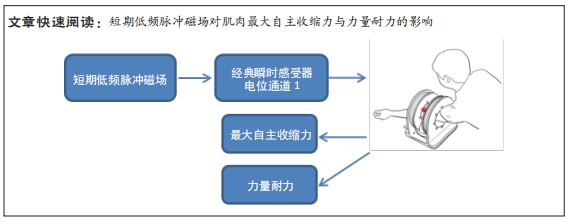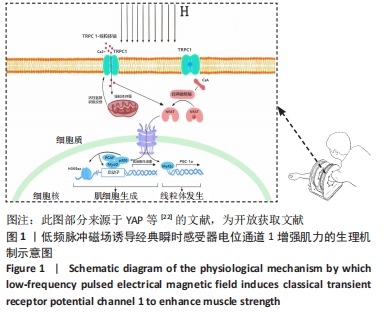中国组织工程研究 ›› 2023, Vol. 27 ›› Issue (11): 1796-1804.doi: 10.12307/2023.200
• 肌肉肌腱韧带组织构建 tissue construction of the muscle, tendon and ligament • 上一篇
短期低频脉冲磁场诱导经典瞬时感受器电位通道1对肱二头肌最大自主收缩力与力量耐力的影响
厉中山1,2,王春露3,刘 洁4,杨铁黎5,孔维签6,李 伟6,张秦阳6,陈 松1,车同同7,李志远8,关荣鑫1,白 石6,9
- 1东北大学体育部,辽宁省沈阳市 110819;2福建师范大学体育科学学院,福建省福州市 350117;3北京体育大学冰雪运动学院,北京市 100084;4中国医科大学科学试验研究中心,辽宁省沈阳市 110122;5首都体育学院,北京市 100191;6沈阳工业大学信息科学与工程学院,辽宁省沈阳市 111003;7清华大学体育部,北京市 100084;8浙江大学公共体育与艺术部,浙江省杭州市 310058;9辽宁省磁医学检测与治疗专业技术创新中心,辽宁省沈阳市 110034
Effects of short-term low-frequency pulsed electrical magnetic field-induced classical transient receptor potential channel 1 on maximum voluntary contraction and strength endurance of the biceps brachii
Li Zhongshan1, 2, Wang Chunlu3, Liu Jie4, Yang Tieli5, Kong Weiqian6, Li Wei6, Zhang Qinyang6, Chen Song1, Che Tongtong7, Li Zhiyuan8, Guan Rongxin1, Bai Shi6, 9
- 1Department of Physical Education, Northeastern University; 2School of Sports Science, Fujian Normal University; 3Beijing School of Ice and Snow Sports, Beijing Sport University; 4Scientific Research Center of China Medical University; 5Capital University of Physical Education And Sports; 6School of Information Science and Engineering, Shenyang University of Technology; 7Department of Sports, Tsinghua University; 8Department of Sports, Zhejiang University; 9Liaoning Provincial Magnetic Detection
摘要:

文题释义:
磁刺激的作用:可有效调节与改善神经及血液系统水平,对生物膜的离子转运能力发挥影响,并导致一系列生理和生化过程的变化,从而影响细胞和组织生物电活动的相关过程。
脉冲磁场:由脉冲发生装备所产生的脉冲电流在线圈中产生的一种瞬态电磁场。
背景:力量素质是人类进行身体活动的必备要素,短暂的低频脉冲磁场刺激可诱导和激活经典瞬时感受器电位通道1(classical transient receptor potential channel 1,TRPC1),并引发小鼠骨骼肌生长与重塑,从而对肌组织产生一系列生理支持效应,该机制是否会引发人体骨骼肌生理结构与工作能力的变化,并作为一种全新的人体肌力提升手段尚无研究。
目的:选用可激活TRPC 1的特定低频脉冲磁场作为外源性刺激,以观察并验证短期刺激对人体肱二头肌最大自主收缩力与力量耐力的影响。
方法:选择普通成年健康受试者27例,随机分为训练组、照射组、训练+照射组,每组9例。训练组采用抗阻训练,训练+照射组每次接受10 min低频脉冲磁场刺激(强度1.5 mT,频率3 300 Hz)后即刻进行抗阻训练,照射组只进行10 min低频脉冲磁场刺激,试验周期9 d,间隔48 h进行1次训练或照射,为了观察低频脉冲磁场与抗阻训练结合是否会产生增益效果,训练组与训练+照射组在5次训练前后采集最大自主收缩力的肌电信息,照射组只在第1,3,5次进行最大自主收缩力测试,跟踪肌力变化情况。试验后观察3组受试最大自主收缩力值、1次重复最大力量、耐力持续时间、中值频率的变化。
结果与结论:①在试验过程中,所有被试的最大自主收缩力值变化与时间交互效应显著(P < 0.01),随时间的推进均出现显著变化,各组内最大自主收缩力值变化与时间交互显著(P < 0.05),组间无交互效应;②各组被试后测最大自主收缩力值、1次重复最大力量、耐力持续时间、中值频率相比前测均显著提升,其中训练组各指标提升率依次为19%,23%,28%,18%,训练+照射组提升率依次为11%,10%,53%,18%,照射组各指标提升率依次为28%,18%,27%,6%;③训练+照射组的中值频率显著高于照射组(P < 0.05),与训练组无显著性差异;④通过对训练组与训练+照射组每次训练前后的最大自主收缩力肌电均方根振幅平均值对比发现,训练组前2次训练后最大自主收缩力肌电均方根振幅平均值显著下降(P < 0.05)。⑤结果证实:在强度1.5 mT,频率3 300 Hz的脉冲磁场短期刺激方案下,人体肱二头肌最大自主收缩力值和力量耐力显著提升,低频脉冲磁场诱导TRPC1促进肌组织工作能力提升这一机制在人体上得到有效验证;在最大力量提升效果上,低频脉冲磁场刺激与该试验进行传统抗阻训练的两组最终力量水平一致;抗阻训练结合脉冲磁场刺激在训练过程中可体现出更好的抗疲劳能力,以及保持肌力稳定增长的功效,这种结合在训练初期可在相同负荷下使局部肌群更多的运动单位获得训练刺激,提升整体训练效率;在力量耐力提升效果上,低频脉冲磁场刺激可使肌肉等长收缩时间延长,抗疲劳能力提升,低频脉冲磁场刺激结合抗阻训练相比单纯进行低频脉冲磁场刺激可带来更加有效的力量耐力增益效果。
https://orcid.org/0000-0002-9010-609X(厉中山);https://orcid.org/0000-0001-5297-6353(白石)
中国组织工程研究杂志出版内容重点:组织构建;骨细胞;软骨细胞;细胞培养;成纤维细胞;血管内皮细胞;骨质疏松;组织工程
中图分类号:
